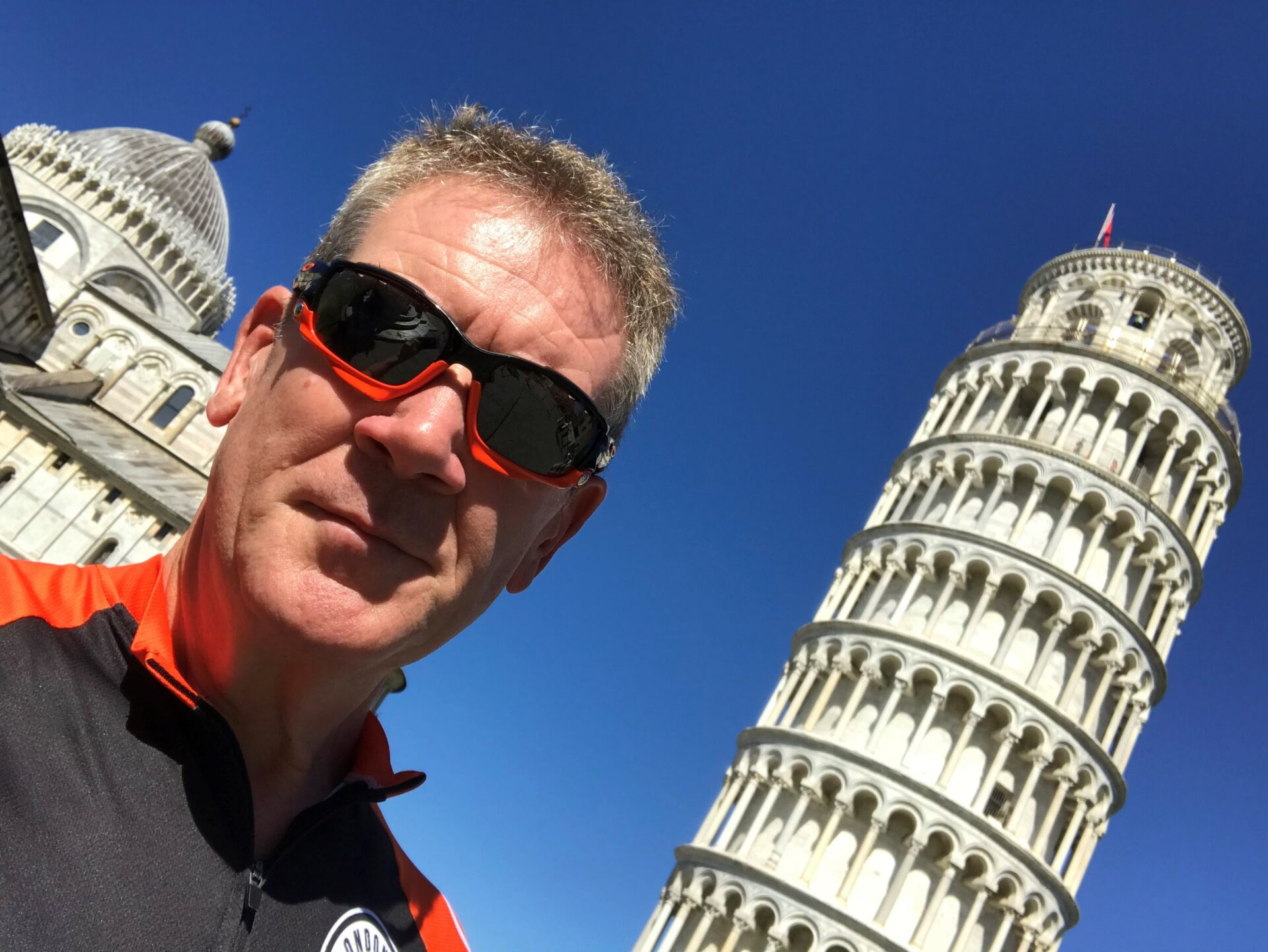2nd May 2023
Bob Munro – Myeloma UK.

Bob is a volunteer Patient Advocate and major fundraiser for Myeloma UK, with events this year including a pioneering Pisa-Rome cycle for 50 family and friends:
| DATE | TOURNAMENT | VENUE | CHARITY PARTNER | ENTRY FEE |
| TBC – AUG | Yorkshire Sportif | Waspwaisted | Supporter led event – Myeloma UK | TBC |
| TBC | Quiz night / music bingo | TBC – South | Supporter led event – Myeloma UK | |
| 20/09/23 – 23/09/23 | Pisa to Rome cycle | Pisa / Rome | Supporter led event – Myeloma UK |
Charity Information: Myeloma UK – Get information, help and support.
Bobs story:
Bob Munro – Lucky Man Living The Dream
To describe yourself as lucky when you’ve been diagnosed as having a rare incurable bone marrow cancer could easily qualify you for a visit from the men in white coats, but then what’s another couple of white coats when you’ve been surrounded by them for over 11 years?
It certainly wasn’t my first reaction when the consultant treating me for pneumonia told me I had a tumour. “You mean cancer?” I interrupted, sensing that this wasn’t a word he wanted to use. “Yes, it’s in your bone marrow and it’s called myeloma”, which, it turns out, 97% of people, including me, have never heard of. I’ve had better news.
As I dabbed away tears I managed to take on board ‘rare, incurable, treatable, new drugs, great strides’ but the fact that it was in my bones strongly suggested to me I was in big trouble. Surely once a cancer has migrated to your bones, you were finished? And his coup de grace “oh, and I strongly advise you not to Google it”, meaning you didn’t need to be Sherlock Holmes to know I was in trouble.
It was no wonder he gave me that earnest but useless piece of advice; 25% of newly diagnosed patients die within the first year and only 46% live for 5 years. But, and here’s where I start to get lucky, my cup is resolutely half full, some would say I’m foolishly optimistic, naturally focussing on the positives in any situation. Google also told me the average age at diagnosis is 69, and less than 35% of patients are under 65. I was 52 and still playing 5-a-side football; surely youth and fitness must improve my chances of being in the 46%? It does, so does not having an aggressive strain.

Personally, I’ve discovered a passion for fund raising and for cycling, both of which could help prolong the quality life of patients like me, and contribute towards the cure which I believe is not far away.

Myeloma, cancerous plasma cells, crowd out the production of red and white blood cells in the bone marrow, leaving sufferers anaemic and with seriously compromised immune systems, hence my raging pneumonia and immediate blood transfusions. It also attacks bones, often resulting in catastrophic collapsed vertebra, and destroys the kidneys. My excessive tiredness; ”Stop yawning Dad”, and stubborn infections, suggested I’d had myeloma for a couple of years, “ but I had neither serious vertebra or kidney damage. This could have been so different if I hadn’t recklessly gone skiing with what felt like flu and developed pneumonia, leading to a diagnosis which could otherwise have been delayed years. Oh yes, that was lucky.
Didn’t he say there had been new drugs developed recently and it was treatable? Yes, and 20 years ago there was virtually nothing available, and since my diagnosis there have been an incredible number of new Myeloma treatments, the most for any cancer, so you could say I was……..you get the picture. Which is one of the reasons I’m such a, sometimes unfashionably, huge fan of Big Pharma, I literally wouldn’t be alive without it.
Now in case you’re thinking this is a rather flippant recollection, coloured by successful treatment to a state of complete remission, think again. The first day’s treatment, a cocktail of 40+ chemotherapy tablets including the notorious, and previously banned thalidomide, left me hospitalised again for 3 weeks. And after 4 months of treatment my response was ‘sub-optimal’ ie: ‘it didn’t work’. It also left me blind in one eye as the blood thinners I self-injected every day sent blood gushing through my retina. “That was unlucky” said my Ophthalmist. I didn’t see it coming either.
The second treatment also failed to dent the myeloma and left me with permanent numbness in my feet. My consultant then suggested we “smash your Myeloma” with 2 doses of a rather nasty cocktail of 6 chemotherapy drugs at once. Apart from losing my hair, I felt relatively unscathed, unfortunately so did the myeloma, in fact my biomarkers went up.
The aim had been to lower these biomarkers sufficiently to undergo a stem cell transplant – a huge chemo blast to the bone marrow followed by a transplant of the stem cells drawn from my blood. But with the biomarkers still high, this plan was shelved. So after 12 months and 4 failed and pretty gruelling treatments, my myeloma was classed as refractory ‘resistant to treatment’ and relapsed, and things were looking pretty grim. Was I worried? “Would it help?”
My consultant then prescribed the very latest drug, Revlimid, and the results were almost immediate. My biomarkers began falling to manageable levels and the lower toxicity of the drug meant I started to feel more normal again. I resolved to do everything I could to improve my chances of surviving and started walking and improving my diet. During 2013, I recovered some fitness and shed the 2 stone in weight I had accumulated during treatment – it’s hard to resist chocolate and ice-cream when you might have already had your last beach holiday, and then 2 more stone – easier when it might actually help prolong your life.
But my real fitness epiphany had been gestating since my drug filled, TV fest sofa residence in the summer of 2012, when I watched every minute of the Bradley Wiggins’ victory in the 3 week Tour de France. I’d swooned over the scenery and marvelled at the athleticism of the riders and when I watched Chris Froome win in 2013 it strengthened my determination to try road cycling. And, like the big kid I am, I imagined myself riding in a peloton into Paris and up to the Arc de Triomphe.
The objections from ‘the Boss’ delayed my cycling debut considerably. “Too dangerous. Don’t you go killing yourself on a bike now after all I’ve been through” (I’ve?). But in July 2014 I bought my first carbon framed road bike and some very unflattering lycra – all the gear and no idea, and within a year I’d become the fittest I’d been for decades and cycled a 120 mile stage of the Tour de France in Normandy, one day before the pros. If only I’d realised years ago that I was a natural at this cycling lark but as Edith said, je ne regrette rien.
At the end of 2014 I turned to fund raising. Myeloma’s bete noire is that it mutates and eventually overcomes the current drugs’ ability to suppress it, meaning patients need a supply of newer and better drugs to extend their lives until a cure is found. The most effective contribution I could make was to help fund the research carried out by Myeloma UK, the country’s only dedicated myeloma charity.
But when I approached Myeloma UK to ride in their cycle events, they told me this wasn’t something they had ever organised. The bigger charities have mass participation marathons, triathlons, cycle rides etc. but the rarity of myeloma – there are only around 17,500 patients in the UK – meant that the smaller Myeloma UK had been concerned about the viability of such an event.
Having witnessed the exponential growth of cycling and the Mamil demographic, and researched the logistics of staging an iconic London Paris Ride, I convinced them it could be done. They went for it, and in May 2016 it all came together as 45 of my family and friends, including my 2 sons Ross and Joe, plus another 80 riders; patients, brothers, sisters, sons, daughters and friends of patients, consultants, researchers and pharmaceutical company teams, set off from a gloriously sunny Greenwich Park to cycle the 300 miles, in 4 days, to Paris with full professional back-up, including motor cycle escorts for rolling road closures – just like the pros.
Bound together with shared stories of adversity and hope for the patients, the considerable challenge of cycling 80 miles a day and the evening ‘rehydration’ sessions, the sense of camaraderie was palpable.
On Sunday afternoon, as the police closed the roads and escorted us over the cobbles to the Arc de Triomphe and the Eiffel Tower, there wasn’t a dry eye to be seen, least of all from me. Truly a lifetime experience was the common consensus, I couldn’t argue with that. We had raised well over £300,000 for the research and lobbying which will help accelerate the development and availability of the next line of drugs to keep myeloma patients like me alive. The event became and annual event raising over £1.5 million by 2022.
I’m very fortunate that I can cycle and have a good quality of life, despite the side effects of the 15-20 tablets I take every day, that’s over 100,000 since I was diagnosed! – single-handedly supporting the pharma industry. And I’m living (cycling) proof of the strides being made in the development of Myeloma drugs, as my ‘new’ drug of 2013 gradually stopped working in 2016, just as two new ones became available and got my numbers to manageable levels once again. And in 2019, another new combination picked up the slack, until, in 2022 I went on a trial for an entirely new class of drug. Despite a rollercoaster of severe side-effects, including a period where I couldn’t walk, and then only with sticks, I have emerged, after a year on the trial, in my first ever full remission and I’m back cycling.
So you can see why I’m such a big fan of Pharma. However, the cost and availability of these new drugs, particularly in the UK, will always be a massive issue, and this is where Myeloma UK do such a valuable job in bringing together the financially, diametrically opposed Pharma companies and NICE/NHS parties, as the honest broker and patient advocate. We need each other.
Naturally, my remarkable first ever remission means I’ve returned to fundraising for Myeloma UK, and specifically to my new adventure, first scheduled in 2020, Pia to Rome, 4 days, 300 miles, for 50 family and friends in 2023. Our target is £100,000. More details in the next blog.
Through my adversity, I’ve discovered a passion for cycling and fundraising, which together could help prolong the quality life of patients like me, and contribute towards the cure which I believe is not far away.
In 2016, I cycled down the Champs-Elysees in Paris, in 2019 I cycled over some of iconic Tour de France Mountain tops and in 2018 the granddaughter I thought I would never see was born. Tell me I’m not a lucky man.

